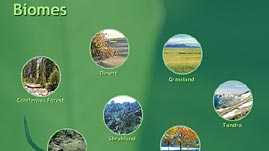Teachers' Domain - Digital Media for the Classroom and Professional Development
User: Preview

Source: NASA's Earth Observatory
The distribution of plants and animals around the world is anything but random. Instead, it is a result of the interplay of individual environmental tolerances of species and the environmental conditions, especially variations in temperature and precipitation. These interactions result in biomes, the categories into which ecologists organize similar communities of plants, animals, and the environmental conditions in which they live. This interactive resource adapted from NASA features some of the physical and biological characteristics of seven of the world's biomes.
Our planet supports an astounding variety of plant and animal life. The earliest European explorers and naturalists traveling beyond the confines of their home continent discovered scores of new species and witnessed diversity beyond their wildest imaginations. They also observed something we take for granted today: plants and animals are not randomly scattered around the planet, but are distributed in distinct patterns. If you travel from one continent to another, change latitude by 10 or 20 degrees, or ascend or descend 1,000 meters (3,300 feet) in elevation, you're likely to encounter plants and animals that are dramatically different from those living where your journey began.
Plants and animals that live in extreme environments often exhibit highly specialized structures and physiologies that enable them to survive where most other organisms cannot. Not surprisingly, the patterns of plant and animal distribution on Earth are closely tied to precipitation and temperature patterns.
Ecologists group distinct communities of plants and animals living together under the same environmental conditions into categories called biomes. This interactive feature highlights seven commonly recognized biomes: coniferous forests, temperate deciduous forests, deserts, grasslands, rainforests, shrublands, and tundra. As the names of some biomes imply, each is typically defined by one or more of the main plant types that grow there, and these reflect the biome's climate.
Interestingly, although the characteristics of biomes are tied closely to geographic location, their distribution has little to do with country and continental borders. Deserts, after all, are found all over the world. So, too, are temperate deciduous forests, grasslands, and shrublands.
 Loading Standards
Loading Standards Teachers' Domain is proud to be a Pathways portal to the National Science Digital Library.
Teachers' Domain is proud to be a Pathways portal to the National Science Digital Library.
